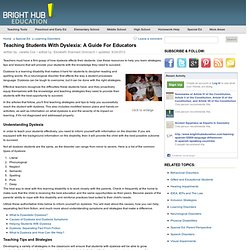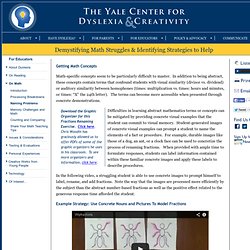

A Resourceful Guide to Teaching Students with Dyslexia. Written by: Janelle Cox • edited by: Elizabeth Stannard Gromisch • updated: 9/24/2012 Teachers must have a firm grasp of how dyslexia affects their students.

Use these resources to help you learn strategies, tips and lessons that will provide your students with the knowledge they need to succeed. Dyslexia is a learning disability that makes it hard for students to decipher reading and spelling words. It's a neurological disorder that affects the way a student processes language. Dyslexia can be tough to overcome, but it can be done with the right strategies.Effective teachers recognize the difficulties these students have, and they proactively equip themselves with the knowledge and teaching strategies they need to provide their students with the best opportunity to succeed.In the articles that follow, you'll find teaching strategies and tips to help you successfully reach the student with dyslexia. What Do Teachers Really Think of Quiet Students? Did you catch the recent news story about Natalie Munro, the high school English teacher from Pennsylvania who blogged her true feelings about her students?

Apparently failing to comprehend the public nature of the Internet, she mused about the nasty things she wished she could write on her students’ report cards. It was an abuse of trust, and a blinkered use of the blogging medium. But that’s not what I want to focus on; others have already covered that very effectively. I want to talk about Munro’s view of quiet and shy students. Here, according to her blog entry of January 21, 2010 (since removed) is what she wished she could put on their report cards:
The Highly Sensitive Child. What is a Highly Sensitive Child?

A highly sensitive child is one of the fifteen to twenty percent of children born with a nervous system that is highly aware and quick to react to everything. This makes them quick to grasp subtle changes, prefer to reflect deeply before acting, and generally behave conscientiously. They are also easily overwhelmed by high levels of stimulation, sudden changes, and the emotional distress of others. Because children are a blend of a number of temperament traits, some HSCs are fairly difficult--active, emotionally intense, demanding, and persistent--while others are calm, turned inward, and almost too easy to raise except when they are expected to join a group of children they do not know.
But outspoken and fussy or reserved and obedient, all HSCs are sensitive to their emotional and physical environment. Is my child highly sensitive? So, what now? But, for all of that to blossom, they absolutely must be raised with understanding. Join Our Mailing List. Dysgraphia for students. Dysgraphia - info for students Is it hard for you to communicate in writing?

When you are writing with a pen or pencil, do any of these things apply to you: A mixture of small letters and capitals Letters of uneven shapes and sizes Unfinished letters A strange way of holding the pen Pain in the hand or arm Talking to yourself? If you are reluctant to carry out writing tasks because of things like this, and your writing is generally very hard to read, you may be dysgraphic.
As with dyslexia, there are a lot of indicators ‘on the list,’ but you are said to be dysgraphic if most of them apply to you all the time. Dysgraphia is nothing to do with intelligence. An American book describes dysgraphia as: "writing skills (that) ...are substantially below those expected given the person's ...age, measured intelligence, and age-appropriate education". Indicators of dysgraphia Dysgraphic people usually feel pain while writing.
Indicators which may be part of dysgraphia Emotional effect Vision issues 1. 2. Naming Problems in Math * Yale Center for Dyslexia & Creativity. Getting Math Concepts Math-specific concepts seem to be particularly difficult to master.

In addition to being abstract, these concepts contain terms that confound students with visual similarity (divisor vs. dividend) or auditory similarity between homophones (times: multiplication vs. times: hours and minutes, or times: “X” the 24th letter). The terms can become more accessible when presented through concrete demonstrations.
Download the Graphic Organizer for this Fractions Renaming Exercise. Click here. Difficulties in learning abstract mathematics terms or concepts can be mitigated by providing concrete visual examples that the student can commit to visual memory. In the following video, a struggling student is able to use concrete images to prompt himself to label, rename, and add fractions. Faces of Learning. All Kinds of Minds. Responsive Classroom.